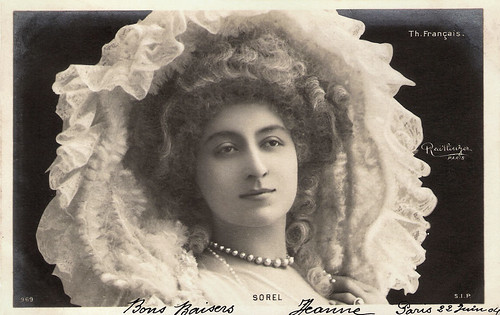
French postcard by S.I.P., no. 969. Sent by mail in 1904. Photo: Reutlinger, Paris.

French postcard by S.I.P., no. 89/14. Photo: Reutlinger, Paris.
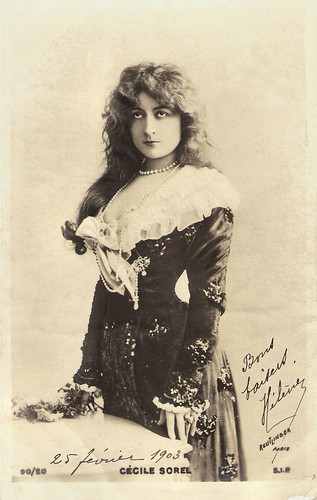
French postcard by S.I.P., no. 90/20. Sent by mail in 1903. Photo: Reutlinger, Paris.
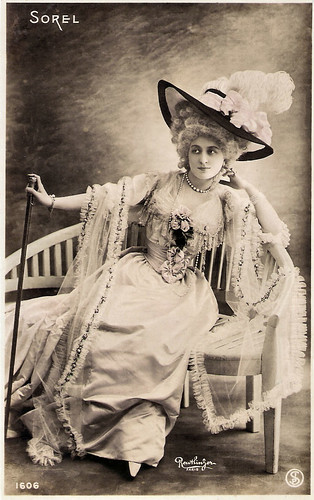
French postcard by S.I.P., no. 1606. Photo: Reutlinger, Paris.
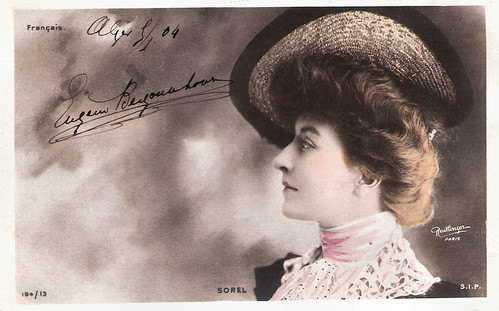
French postcard by S.I.P., no. 194/13. Photo: Reutlinger, Paris.
Grandes coquettes
Cécile Sorel was born as Céline Émilie Seurre in Paris in 1873. Very early, she was attracted by the theatre. She was a student of Delaunay and Mademoiselle Favart, and during the early years of her career, she played in a small boulevard theatre.
In 1899, she started to perform at the Odéon and in 1901, at the Comédie-Française, where she specialised in playing ‘grandes coquettes’. Her style was very recognisable and is now considered exaggerated, with her declamatory tone and articulated diction.
It was also the style of Sarah Bernhardt. Like the latter, she is particularly associated with the role of the courtesan Célimène in Le Misanthrope by Molière. Other success roles were La Dame aux camellias and Marion Delorme by Victor Hugo.
In 1904, she was elected 339th ‘Sociétaire’ (member) of the Comédie-Française, and Cécile Sorel would remain there until 1933. She enjoyed great popularity, and worked with some of the greatest personalities of her age, including Clemenceau, playwright Edmond Rostand (Cyrano de Bergerac) and actor Lucien Guitry (father of Sacha Guitry).
She performed on both sides of the Atlantic and was the eternal fiancee of Witney Warren, a wealthy American.
Eventually she married the somewhat younger Count de Segur Lamoignon, great-grand-son of the Countess de Segur, and a stage actor under the name of Guillaume de Sax. Although the count soon abandoned her for another woman, they never divorced. Sorel remained a ‘Countess’ all her life.
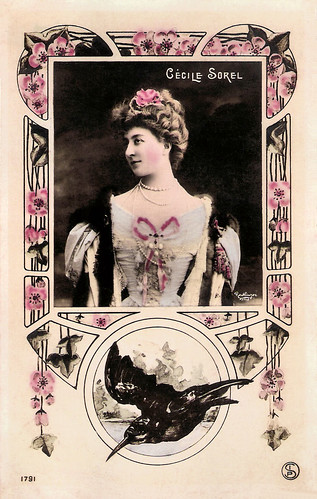
French postcard by S.I.P., no. 1791. Sent by mail in 1909. Photo: Reutlinger, Paris.

French postcard by S.I.P., no. 1915. Photo: Reutlinger, Paris. Sent by mail in 1908.
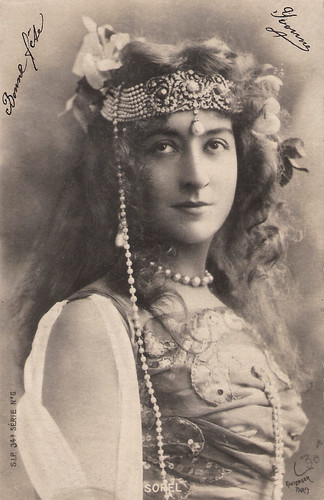
French postcard by S.I.P., series 34, no. 6. Photo: Reutlinger, Paris.
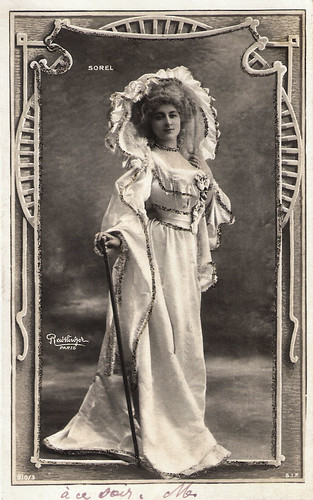
French postcard by S.I.P., no. 910/3. Photo: Reutlinger, Paris.
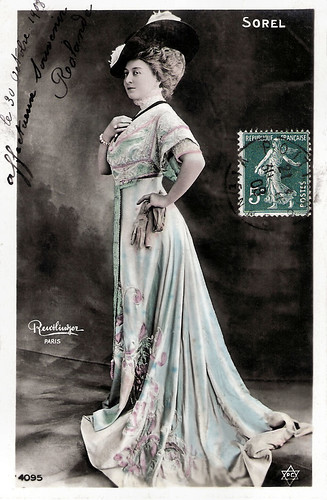
French postcard by PC, no. 4095. Photo: Reutlinger, Paris.
A revue star with feathers and glitter
From 1909 on, Cécile Sorel appeared incidentally in the cinema. She made her film debut in the silent short La Tosca (André Calmettes, Charles Le Bargy, 1909), a Film d’art production by Pathé Frères, based on the play by Victorien Sardou.
That year she appeared in another short silent film, Le crime à Zidore (Maurice de Féraudy, 1909) with Eugénie Noris.
In 1933 she left the classical theatre of the Comédie Française, and at the age of 60 she became a revue star with feathers and glitter at the Casino de Paris. That year she fell down the 45 stairs at the Casino and her simple remark "L'ai-je bien descendu? - Have I gone down well?" was widely quoted.
Nearly 30 years after her film debut, she returned to the cinema in Les perles de la couronne/The Pearls of the Crown (Sacha Guitry, 1937) in which she played a courtesan. The film tells the history of a set of perfectly matched pear-shaped pearls, that pass through many hands.
Her next film was L'an 40/The year 40 (Fernand Rivers, 1941) with André Alerme and Jules Berry. It is 1940 and the Germans have invaded France. A well off couple flees the invaders and gradually they lose all their material possessions but they discover the true meaning of life instead. The film premiered in Marseille at the Capitole Cinema on 31 January 1941, but the Vichy government banned it two days later and had all copies destroyed. None are known to have survived.
Her final film was the portmanteau film Les petits riens/Little Nothings (Raymond Leboursier, 1942) with Raimu and Fernandel.
In 1950 Cecile underwent a religious conversion, took monastic vows, and spent much of the remainder of her life in prayer and study.
Reputedly, she was one of the richest women in the world, owning several castles, yachts, Cécile Sorel passed away after a heart attack in 1966 château de Hennequeville in Trouville-sur-Mer, France. She was 92. She is buried at the Cimetière de Montparnasse.
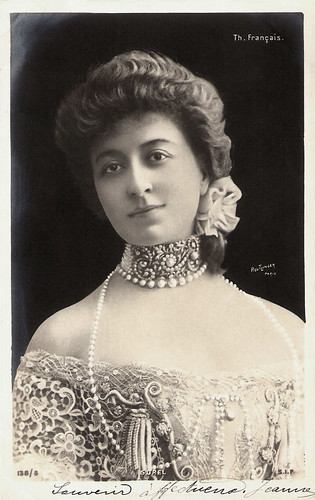
French postcard by S.I.P., no. 136/8. Photo: Reutlinger, Paris.
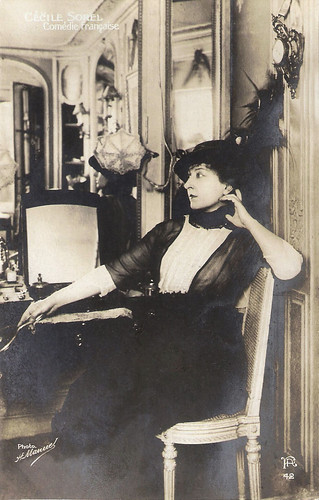
French postcard by F.A., no. 42. Photo: H. Manuel.

French postcard by Wyndham Ed., no. W 109.
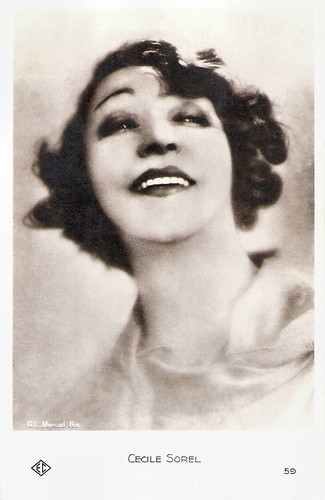
French postcard by E.C. (Editions Chantal), Paris, no. 59. Photo: G.L. Manuel Frères, Paris.
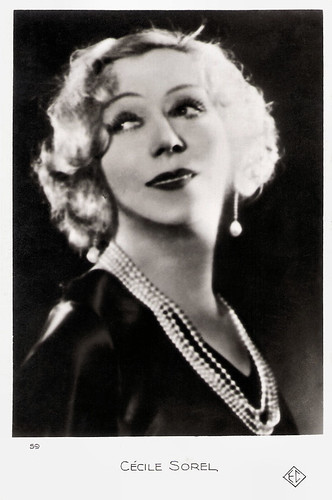
French postcard by EC (Editions Chantal), no. 59.
Sources: Bob Hufford (Find A Grave), Wikipedia (French) and IMDb.
No comments:
Post a Comment